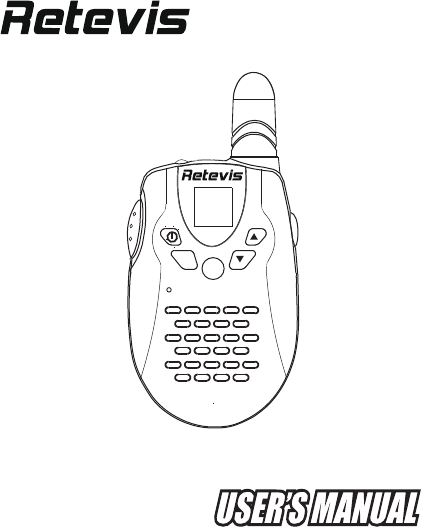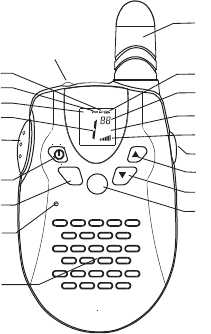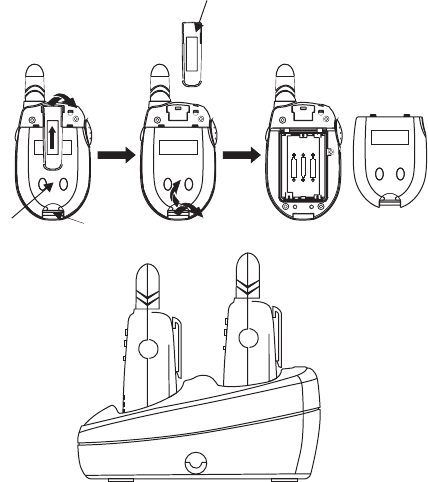HENAN ESHOW ELECTRONIC COMMERCE RETEVISRT602 Walkie Talkie User Manual RT602 new
HENAN ESHOW ELECTRONIC COMMERCE CO., LTD Walkie Talkie RT602 new
User Manual

M
C
RT 60 2
RT602

3.CTCSS / Menu option
PIC 01
14.PTT Button
9.Call/Scan Button
10.Speaker
7.Up Button
8.Down Button
11.Microphone
1.Antenna
6. Lamp Button
19.Lamp
15.Channel/Menu item
TX RX
SCAN
13.Power Button
4.TX/RX Icon
12.MENU/
Button
Keypad
Lock
5.Volume
16.Scanning
17.Vox
18.Lock 2.Battery Level
M
C
1

PIC 02
23
20
21
2

E N ~ Ins t r uctions for use
This set includes 2 walkie-talkie units: these are communication
devices which operate on mobile radio frequencies. They come
with 22 channels as well as a back-lit LCD screen, enabling you to
communicate over several kilometres free-of-charge.
NOTE: Please read these user instructions carefully before using
the equipment and retain for future consultation!
● If you carry any kind of personal medical device, consult a
doctor before use.
● To avoid the risk of burns, do not use the device if the antenna
is damaged in any way.
● Do not use the device in a potentially explosive environment
(e.g.around petrol pumps, on the lower deck of a boat or around
a fuel storage installation or chemical products)
● Switch off the device if on an airlane or in a hospital.
● Never use the device in close proximity to a radio to avoid
interference.
● Remove the batteries if the device is not in use for an extended
period of time. Never mix used and new batteries .
● Put the transmitter and antenna at least 32 mm from your face.
Direct the antenna upwards and speak normally.
● Clean the device with a damp cloth. Do not use of cleaning
agents and solvents.
● Do not modify the device in any way. If the device is damaged,
Please make it checked by a qualified professional.
● The device cannot be used to contact the emergency services.
SPECIFIC RECOMMENDATIONS
3

ITEM DESCRIPTION (Pic 01,02)
1. Antenna
2. Battery level indicator
3. CTCSS / Menu option -value
4. RX icon -Displayed when receiving
TX icon -Displayed when transmitting
5. Volume level indicator
6.
7. Adjustor button Up (▲)
8. Adjustor button Down (▼)
9. Call/SCAN button(C)
10. Loud speaker
11. Microphone
12. M: Enter the menu settings
13. On /off button( )
14. Push to talk (PTT)button
15. Channel/Menu item indication
16. Scanning indication:
Displayed during scan mode
17. VOX indication
18 Keypad lock indicator
20. Belt attachment clip
21. Battery compartment cover latch
22. Batteries
23. Battery compartment
Lamp Button
.
19. Lamp
4

BEFO R E U SE ( Pic 02)
To insert batteries into the devices, first remove the belt attach-
ment: lift the attachment clip (20) and press the belt attachment
upwards. Release the Battery compartment cover latch (21) lo-
cated on the rear side of the unit. Open the battery compartment
(23) and insert 3 AAA batteries or NI-MH rechargeable batteries
(22)(not supplied), ensuring that the poles are correctly aligned.
Then close the lid.
USIN G THE TWIN TALKER
1. Turning the device on/off: To turn the devices on or off, press
the on/off button (13) for 3 seconds, there will be a BEEP sound
to confirm.
2. Adjusting the volume: To increase the volume, press the Up
adjustor button ▲ (7) and press the Down ▼ (8) button to de-
crease volume.
Note: The volume level (5) is displayed on the screen.
3. Battery Charge Level/Low Battery Indication
The battery charge level is indicated by the number of squares
present inside the battery icon on the LCD Screen.
Battery Full
Battery 2/3 charged
Battery 1/3 charged
Battery empty
When the battery power is low, the battery icon will flash and there
will be a beep indicating that the batteries need to be replaced or
recharged.
5

4. Receiving/transmitting communications:
The devices are in 'Reception' mode when lit up, i.e. they are ready
to receive a call or sound transmitted on the activated frequency.
When you press the Call tone button (9), the device switches to
'Transmission' mode. There will be sound signal from the walkie
talkies.
● To send a voice message, press the PTT button (14) and speak
into the microphone (11). Continue to press PTT the button until
you finish talking.
Hold the microphone a minimum of 25 mm from your face.
Note:
- The other device must be set to the same channel and have set
the same CTCSS code(see point 7)
- When the transmission is complete and you can release PTT
button (14), the other device will emit a sound (BEEP) to indicate
that this device is ready to transmit.
5. Changing Channels
● Press the MENU button (12)once, the current channel number
flashes on the display.
● Press the - ▲ button (7) or the - ▼ button (8) to change the
channel.
● Press the PTT - button to (14) confirm and return to stand-by
Mode.
Note: If no button is pressed within 15 seconds during setting, the
unit will return to standby.
●
6

6.CTCSS (Continious Tone Coded Squelch System)
License free radio's operating on the 462.5625~467.7250 Mhz
frequency band, like the kids walkie talkie , have 22 available
channels channels. If there are many walkie talkie users in your
neighborhood, there is a chance that some of these users are
operating on the same channel. To prevent that you receive
unknown signals from other users, sub-channels will be needed.
Two radio's will only be able to communicate with each other not
only operating on the same channel but also the same sub-channel.
There are two kind of sub-channels :
● Continuous Tone Coded Squelch System (CTCSS)
When using CTCSS, a low frequency tone (between 67 and 250
Hz) will be transmitted along with the voice signal. There are 38
available tones to choose from. You are free to choose one of
these 38 available tones. Due to filtering, these tones will
generally not be audible so they will not disturb the
communication.
7.CTCSS
● Press the PTT-button(14) twice : The current CTCSS code
flashes on the display.
● Press the ▲-button(7) or the ▼-button(8) to change to another
code.
● Press the PTT-button(14) to confirm and return to stand-by mode.
Note: To disable CTCSS, select code "0F? for CTCSS in the menu.
When pressing PTT button to confirm, "OF" will be displayed.
7

8. VOX Selection
The walkie talkie has VOX function. In VOX mode, the walkie talkie
will transmit a signal when it is activated by your voice or other
sound around you without pressing PTT button. VOX operation is
not recommended if you plan to use your walkie talkie in a noisy or
windy environment.
Note: VOX mode will be overrided when you press the PTT - button
“”.
● Press the MENU- button(12) three times, the current VOX setting
flashes on the display and the VOX icon is displayed.
● Press to set the VOX sensitivity level between 1 and 3
(level 3 is the most sensitive level).
● Press until “OF” appears on the display,to turn VOX OFF.
● Press the PTT-button(14) to confirm and return to stand-by mode.
9. Scanning for an active radio channel on the same CTCSS
● Press CALL -button(9) for 3 seconds : The 'Scan' function
indicator (16) will appear on the screen and the channel (15)
will scan continuously from 1 to 22.
● Press the ▼-button(8) to start the channel scan from 22 to 1.
Once an active channel is found, the scanning will stop and you
can listen to the transmission.
When the transmission on the found channel stops, the scanning
will resume automatically.
Note: If you press the PTT button(14) while listening to a found
channel, the Radios will go back in stand-by mode on the
found channel.
14
▲-button(7)
▼-button(8)
8

10. Call Tones
A call tone alerts others that you want to start talking.
1. Setting the Call Tone
The Walkie talkie has 10 different call tones.
● Press the MENU- button(12) four times, “CA” is displayed and
the current call tone is flashing.
● Press the ▲-button(7) or the ▼-button(8) to change to another
Call Tone.
● Press the PTT - button(14) to confirm and return to stand-by
Mode.
2. Sending a call Tone
Press the CALL-button(9) briefly. The call tone will be transmitted
on the set channel.
11. Key-Tone On / Off
When a button is pressed, the unit will beep briefly.
To set the key-tone.
● Press the MENU- button(12) five times. “tO” will be displayed.
● Press ▲ to enable (ON) or ▼ disable the Key Tones (OF).
● Press the PTT - button(14) to confirm your selection and return to
the standby mode.
12. Roger Beep On/Off
Roger Beep function is that when you finish talking and release
PTT-button, the device will send out a roger beep to confirm that
you have stopped talking.
9

To set the Roger Beep.
● Press the MENU- button(12) six times. “rO” will be displayed.
● Press ▲ to enable (ON) or ▼ disable the Roger Beep (OF).
● Press the PTT - button(14) to confirm your selection and return
to the standby mode.
13.Button Lock
● Press and hold the MENU- button(12) for three seconds to
activate the Button lock mode. The button lock icon (a key near
the battery indicator) will be displayed on the LCD Screen.
● Press and hold the MENU- button(12) again for three seconds
deactivate button lock
Note:The PTT - button(14) , the CALL -button(9) and the on/off
button (13) will still be functional when the Button Lock is
activated.
14. Display back light
To activate the backlight of the LCD display, press any button
except the MENU- button(12).
The LCD backlight will light up for 5 seconds.
15. Battery saving function
When the device has not been used for 6 seconds, the economy
mode is automatically activated. This does not affect the reception
of transmissions and the standard mode is automatically reactivated
as soon as a signal is detected.
10

16.BUILT-IN FLASH LIGHT
As an added feature,your walkie talkie has a built-in flashlight that
can be used in sending light signals or for your lighting needs with
a button on the right side of the device.
17 Charge The PMR(PIC 02)
In the event you wish to use the unit with rechargeable
battery. You will be requited to use an DC adaptor.
● Install 3.6V “AAA” NI-MH rechargeable battery Pack
into the unit.
● Place the unit into the Charger Base.
● Put the adaptor into the wall outlet and insert the round end
into the Charge Jack on the rear of the charger base.
● The LEDlight on Charger Base will turn RED once
electricity get connected.
11

Frequency 446.00625 446.01875 446.03125 446.04375
Channel 5 6 7 8
Frequency 446.05625 446.06875 446.08125 446.09375
Channel 1 2 3 4
Frequency 462.5875 462.6125 462.6375 462.5625
Channel 5 6 7 8
Frequency 462.6625 462.6875 462.7125 467.5625
Channel 1 2 3 4
Frequency 462.6000 462.6250 462.6500 462.6750
Channel 21 22
Frequency 462.7000 462.7250
Channel 17 18 19 20
Frequency 467.5875 467.6125 467.6375 467.6625
Channel 13 14 15 16
Frequency 467.6875 467.7125 462.5500 462.5750
Channel 9 10 11 12
EU Channel Frequency
USA Channel Frequency
12
FCC NOTICE AND DECLARATION
ThisdevicecomplieswithPart15oftheFCCRules.Operationissubjecttothefollowingtwoconditions:
1.Thisdevicemaynotcauseharmfulinterference,and
2.Thisdevicemustacceptanyinterferencereceived,includinginterferencethatmaycauseundesired
operation
Any modification to a walkie-talkie to receive transmissions from Service frequency bands voids the
certification of the scanning receiver, regardless of the date of manufacture of the original unit. In addition,
the provisions of FCC §15.23 shall not be interpreted as permitting modification of a scanning receiver to
receiver Cellular Radiotelephone Service the Cellular Radiotelephone transmissions.
Caution:
.TomaintaincompliancewiththeFCC’sRFexposureguideline,holdthetransmitterandantennaat
least1inch(2.5centimeters)fromthefaceandspeakatanormalvolume/pitch,withtheantenna
pointedupandawayfromtheface.
.ThisdevicecompliedwithFCCRFradiationexposurelimitssetforthanuncontrolledenvironment.
.Useonlytheantennasupplied.Unauthorizedantennas,modifications,orattachmentscoulddamage
thetransmitterandmayviolateFCCregulations.
Thisproductisauthorizedtooperateatadutyfactornottoexceed50%.Totransmit(talk),pushthe
PTT,toreceivecalls,releasePTTkey.Transmitting50%ofthetimeorlessisimportantbecausethe
radiogeneratesRFenergyonlywhenittransmits.Whenwornonthebody,alwaysusethe
manufacturer’sbeltclipandaccessoriesapprovedwiththisproduct.Usenon‐approvedaccessoriesmay
resultinexposurelevelswhichexceedtheFCC’sRFexposurelimits.
The device operates on GMRS (General Mobile Radio Service) frequencies, which require an FCC (Federal
Communications Commission) license. You must be licensed prior to transmitting on all channels, which comprise of
GMRS channels. Serious penalties could result for unlicensed use of GMRS channels, in violation of FCC rules, as
stipulated in the Communications Act's Sections 501 and 502 (amended).
You will be issued a call sign by the FCC, which should be used for station identification when operating the radio on
GMRS channels. You should also cooperate by engaging in permissible transmissions only, avoiding channel
interference with other GMRS users, and being prudent with the length of their transmission time. To obtain a license
or ask questions about the license application, contact the FCC at 1-888-CALL-FCC or go to the FCC's website:
http://www.fcc.gov and request form 605.